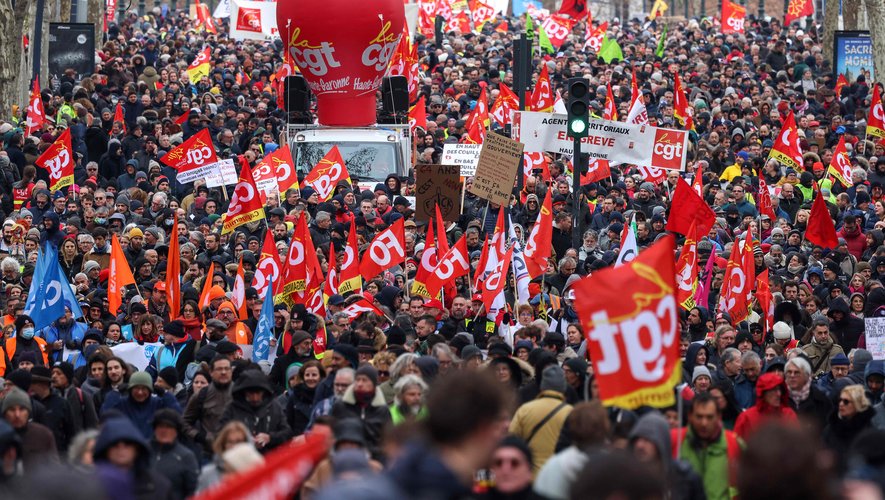
The day included strikes in public transport, education, energy companies and refineries, among other sectors.
According to the unions, some two million people mobilized throughout France, a participation that, however, is less than the last protest on January 31, when they calculated 2.8 million.
In Paris, organizers estimated that some 400,000 people took part in the demonstration, similar to the first day of protests on January 19.
🔴 Arrival of the demonstration in Paris place de la Bastille #manif7february #ReformeDesRetraites pic.twitter.com/527lmadtX5
— Permanent Revolution (@RevPermanente) February 7, 2023
Protesters in the French capital, many of whom were young, marched with banners reading “Save Your Pension” and “Tax Billionaires, not Grandmas.”
In other cities the demonstrations continued to summon thousands. Some 80,000 marched in Toulouse, 50,000 in Bordeaux, 45,000 in Nantes, 40,000 in Le Havre. There are also protests in medium-sized and small municipalities, with numbers that remain high: 7,000 in Niort, 6,000 in Périgueux and 6,000 in Calais, are some examples.
🔴 Third day of mobilizations and strikes in #France against pension reform #Macron
🎙️ @Alberta_Nur student and activist @RevPermanentedenounces the repression of students in #Lille y #Paris #France #greve7fevrier #GreveGenerale7Fevrier pic.twitter.com/jPFAP3sdB4— IzquierdaDiario.es (@iDiarioES) February 7, 2023
Impressive crowd in Toulouse: tens of thousands of people at the start of the demonstration for this 3rd day of the fight against the pension reform in France #greve7fevrier via @RevPermanente pic.twitter.com/B56xakKVOe
— IzquierdaDiario.es (@iDiarioES) February 7, 2023
Strikes continue in education, public services and refineries
Along with the demonstrations, strikes continued in several sectors, with a slight decrease in the number of workers who complied with the strike in transport, energy companies, although the unions confirm that the strike levels in the area of the production of Power prices remain high, cutting power output by almost 4,500 MW between Monday and Tuesday, the equivalent of more than four nuclear reactors.
As for the refinery sector, the strike was maintained with high regard, with the notable fact of the union of many subcontractors in the movement, who participated in the massive blockade of the industrial zones and the port of Le Havre.
Revolution Permanente, the French-language website of The Left Daily, reflected the blockades “in the blockades of the industrial zone of Le Havre organized by the CGT, many employees of Total’s subcontracting companies have joined the movement. It is the This is the case, for example, of employees of Altrad Endel, SPIE HNO or Eramet, all subcontractors of large companies in the area such as Total or Renault (…) In Grandpuits, in the instrument department, 66% of Actemium employees , a Total subcontractor, are on strike.”
Another outstanding fact of the day was the continuation of the youth mobilization, with the seizure and blockades in several secondary schools, also in many universities such as Tolbiac, Le Mirail, Rennes 2, Lille 2, a novelty compared to the previous day.
In Rennes, the Jean Macé high school is blocked by around fifty https://t.co/WnDtnBaZN0. Against the pension reform, alongside workers and students, high school students are in the street! #greve7fevrier pic.twitter.com/XYVUKWpten
— Permanent Revolution (@RevPermanente) February 7, 2023
The overall picture thus shows a massive mobilization and that discontent against the Government continues to be expressed in the streets, while the new day of protest on February 11 is being prepared.
Macron seeks allies in Parliament in the face of social discontent
The new day of protests comes a day after the French Parliament began debating the regressive bill, rejected by the majority of the population, which would increase the retirement age from 62 to 64 by 2030 and a increase in the number of years of contributions, to 43 years, to collect a full pension.
Although the reform is an electoral promise of Macron, observers estimate that his re-election in 2022 was due in large part to the desire of voters to avoid the victory of his rival in the second round, the far-right Marine Le Pen.
Weeks later, the ruling party lost its absolute majority in the Assembly. Now he is seeking the votes of the right-wing opposition of Los Republicanos (LR) to approve the reform, in the face of the refusal of Le Pen and the reformist leftist benches.
While the Government seeks parliamentary allies, the rejection of the reform continues to grow. According to the pollster iPsos, the rejection not only continues at a high level, but it tends to strengthen, with 64% of the French rejecting this pension reform, which represents three points more than the measurement from a week ago.
Faced with this situation, the debate on how to move forward with the protests in the coming weeks remains open: whether to continue with a strategy of the union leaders that reduce the demonstrations to measures of pressure that limits the construction of a relationship of forces that can succeed, or if the measures are deepened to advance towards the construction of a hard movement based on the deepening of the strikes and the paralysis of the key sectors of the economy, as the only way to make the government back down.
Source: www.laizquierdadiario.com

